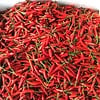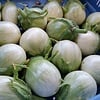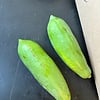Asiatic pennywort
Description/Taste
Pennywort is a creeping plant that spreads out horizontally forming dense mats along marshes, ponds and wetlands. Stems are 5-10 cm high and have a singular rounded fan-shaped leaf. Each stem produces 2 to 4 miniscule whitish pink flowers. Stems, leaves and roots are all edible. When foraging Pennywort be sure that you are collecting specimens from a clean water source, and thoroughly wash leaves before consuming. Pennywort offers little to no aroma and has fresh herbal quality on the palate with notes of wheat grass, parsley and cucumber.
Seasons/Availability
Pennywort is available year-round.
Current Facts
Pennywort is an herbaceous perennial in the Apiceae family, a relative of parsley and carrot. The name Pennywort is a common term given to 20 species of creeping plants found in swampy areas of tropical and sub-tropical climates. It is vital to be sure of identification in the wild, because not all varieties are edible. Centella asiatica is the common Asian variety that is used in both culinary and medicinal applications. It is commonly known as Gotu Kola, Luei Gong Gen, Takip-kohol, Antanana, Pegagan, Pegaga, vallarrai, Kudavan, Asiatic coinwort and Asiatic pennywort. Consumed for its health benefits, Sri Lankans noticed that elephants, renowned for their longevity, often eat the plant.
Nutritional Value
Triterpenoid is the main constituent of Pennywort responsible for treating various skin conditions. It also strengthens nervous functions and memory, reduces inflammation and fevers, clears toxins and relaxes blood vessels.
Applications
Pennywort is most often sold as juice, but the leaves may also be eaten raw, dried, sautéed, or pickled. The juice of Pennywort is quite mild, but the fresh leaves have a much stronger taste and stand up well to bold accompanying flavors such as ginger, lemongrass, garlic, chilies, tamarind, coconut, coriander, fish sauce, sesame and lime.
Ethnic/Cultural Info
Pennywort is one of the most important medicinal herbs used in the Ayurvedic practices of India. It has been used as a meditation aid to develop the chakras at the crown of the head and balance the hemispheres of the brain. Citations of Pennywort’s benefits are found in the thousand year old medical text, ‘Sushruta Samhita’.
Geography/History
Pennywort has a long history throughout eastern portions of Asia, specifically India and Malaysia. Today it may be found in tropical and subtropical countries including parts of India, Pakistan, Sri Lanka, Madagascar, South Africa and Eastern Europe. Pennywort prefers moist or wet soils and full sun, but also tolerates partial shade.



 vegetables
vegetables
 fruit
fruit
 chilli
chilli
 eggplant thai
eggplant thai
 NEW project - GREEN PAPAYA THAI.
NEW project - GREEN PAPAYA THAI.





